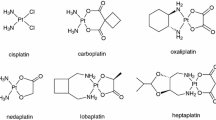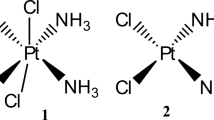Abstract
A review is presented on the successful antitumour drugcis-diamminedichloroplatinum(II), better known as cisplatin. Special attention is given to the synthesis of the compound and related derivatives, and to the nature of the hydrolysis products in blood and in the cell. In the second part of the review the mechanism of action is discussed. Binding to DNA and in particular the formation of intrastrand cross-links between adjacent guanines, to which the Pt(NH3)2 2+ ion is chelated at the N7 atoms, seems to be a very important event. However, at the moment it is not yet known which DNA lesion is responsible for the killing of the tumour cells.
Similar content being viewed by others
References
Reedijk J. Nomenclature for platinum antitumour compounds. In: Hacker MP, Douple EB, Krakoff M, eds. Platinum coordination complexes in cancer chemotherapy. Boston: M. Nijhoff, 1984:3–8.
Rosenberg B, Van Camp L, Krigas T. Inhibition of cell division inEscherichia coli by electrolysis products from a platinum electrode. Nature 1965;205:698–9.
Rosenberg B, Van Camp L, Grimley EB, Thomson AJ. The inhibition of growth or cell division inEscherichia coli by different ionic species of platinum(IV) complexes. J Biol Chem 1967;242:1347–52.
Rosenberg B, Van Camp L, Trosko JE, Mansour VH. Platinum compounds: a new class of potent antitumour agents. Nature 1969;222:385–6.
Roberts JJ, Thomson AJ. The mechanism of action of antitumour platinum compounds. Progr Nucleic Acid Res Mol Biol 1979;22:71–133.
Wiltshaw E. Cisplatin in the treatment of cancer. Plat Met Rev 1979;23:90–8.
Marzilli LG, Eichorn GL. Metal-ions in genetic information transfer. New York: Elsevier/North Holland, 1984.
Van Kralingen CG. Antitumor Platinum Compounds: Synthesis, structure and biological activity. Delft: Delft University of Technology, 1979. Dissertation.
Marcelis ATM. Interaction of antitumor platinum compounds with nucleic acid fragments. Leiden: State University of Leiden, 1982. Dissertation.
Marcelis ATM, Reedijk J. Binding of platinum compounds to nucleic acids, in relation to the antitumor activity ofcis-diamminedichloroplatinum (II) and derivatives. Recl Trav Chim Pays Bas 1983;102:121–9.
Martin RB. Hydrolytic equilibria and N7 versus N1 binding in purine nucleosides ofcis-diamminedichloro-platinum(II). In: Lippard SJ, ed. Platinum, gold and other metal chemotherapeutic agents: chemistry and biochemistry. Washington American Chemical Society, 1983:231–44. (ACS Symposium Series. Vol. 209).
Lippard SJ. New chemistry of an old molecule:cis-Pt(NH3)2Cl2. Science 1982;218:1075–82.
Pinto A, Kippard SJ. Binding of the antitumor drugcis-diamminedichloroplatinum(II) (cisplatin) to DNA. Biochim Biophys Acta 1985;780:167–80.
Prestayko AW, Crooke ST, Carter SK, eds. Cisplatin, current status and new developments. New York: Academic Press, 1980.
Rosenberg B. Some biological effects of platinum compounds. Plat Met Rev 1971;15:42–4.
Reslova S. The induction of lysogenic strains ofEscherichia coli bycis-dichlorodiammineplatinum(II). Chem Biol Interact 1972;4:66–70.
Harder HC, Smith RG, Leroy AF. Template primer inactivation bycis- andtrans-dichlorodiammine platinum for human DNA polymerase α, β, and Rauscher Murine Leukemia Virus reverse transcriptase, as a mechanism of cytotoxicity. Cancer Res 1976;36:3821–9.
Gellert RW, Bau R. X-ray structural studies of metal-nucleoside and metal-nucleotide complexes. In: Sigel H, ed. Metal ions in biological systems. Vol. 8. New York: Marcel Dekker, 1979:1.
Brouwer J, VandePutte P, Fichtinger-Schepman AMJ, Reedijk J. Base-pair substitution hotspots in GAG and GCC nucleotide sequences inEscherichia coli K-12 induced bycis-diamminedichloroplatinum(II). Proc Natl Acad Sci USA 1981;78:7010–4.
Fichtinger-Schepman AMJ, Lohman PHM, Reedijk J. Detection and quantification of adducts formed upon interaction of diamminedichloroplatinum(II) with DNA, by anion-exchange chromatography after enzymatic degradation. Nucl Acid Res 1982;10:5345–56.
Fichtinger-Schepman AMJ, Van der Veer JL, Den Hartog JHJ, Lohman PHM, Reedijk J. Adducts of the antitumor drugcis-diamminedichloroplatinum(II) with DNA: formation, identification and quantitation. Biochemistry 1985;24:707–13.
Rahn RO. Chromatographic analysis of the adducts formed in DNA complexed withcis-diamminedi-chloroplatinum (II). J Inorg Biochem 1984;21:311–21.
Plooij ACM. Effects of cisplatin and related cis- and transplatinum compounds on cultured mammalian cells: genotoxic properties and their molecular background. Leiden: State University of Leiden, 1984. Dissertation.
Chottard JC, Girault JP, Chottard G, Lallemand JY, Mansuy D. Interaction ofcis-[Pt(NH3)2(H2O)2](NO3)2 with ribose dinucleoside monophosphates. J Am Chem Soc 1980;102:5565–72.
Den Hartog JHJ, Altona C, Chottard JC, et al. Conformational analysis of the adductcis-Pt(NH3)2d(GpG) in aqueous solution. A high field (500-300 MHz) nuclear magnetic resonance investigation. Nucl Acid Res 1982;10:4715–30.
Den Hartog JHJ. Cisplatin induced distortions in DNA. Leiden: State University of Leiden, 1985. Dissertation.
Marcelis ATM, Den Hartog JHJ, Reedijk J. Intrastrand cross-linking of the guanines of the deoxytrinucleotide d(G-C-G) viacis-Pt(NH3)2Cl2. J Am Chem Soc 1982;104:2664–5.
Marcelis ATM, Canters GW, Reedijk J. Chelation ofcis-Pt(NH3)2Cl2 by the deoxynucleotide d(C-C-G-G). Recl Trav Chim Pays-Bas 1981;100:391–2.
Tran-Dinh S, Neumann JM, Girault JP, Chottard JC, Igolen J, Huynh-Dinh T. Conformation of d(ATGG)-cisPt(NH3)2 in aqueous solution by proton magnetic resonance spectroscopy. Inorg Chim Acta 1983;79:253–4.
Girault JP, Chottard JC, Guittet ER, Lallemand JY, Huynh-Dinh T, Igolen J. Specific platinum chelation by the guanines of the deoxyhexanucleotide d(T-G-G-C-C-A) upon reaction withcis-[Pt(NH3)2(H2O)2](NO3)2. Biochem Biophys Res Commun 1983;109:1157–63.
Caradonna JP, Lippard SJ, Gait MJ, Singh M. The antitumor drugcis-[Pt(NH3)2Cl2] forms an intrastrand d(GpG) cross-link upon reaction with [d(ApGpGpCpCpT)]2. J Am Chem Soc 1982;104:5793–5.
Den Hartog JHJ, Altona C, Van Boom JH, Van der Marel GA, Haasnoot CAG, Reedijk J.cis-Diammine-dichloroplatinum(II) induced distortion in a doublehelical DNA fragment. J Am Chem Soc 1984;106:1528–30.
Marzilli LG, Reily MD, Heyl BL, McMurray CT, Wilson WD. Evidence for similar structural changes on binding of platinum anti-tumor agents to DNA and nucleosomes. FEBS Lett 1984;176:389–92.
Den Hartog JHJ, Altona C, Van Boom JH, Reedijk J. A phosphorus NMR study of the reaction products ofcis-diamminedichloroplatinum(II) with a double helical oligonucleotide and with DNA. FEBS Lett 1984;176:393–7.
Author information
Authors and Affiliations
Rights and permissions
About this article
Cite this article
Reedijk, J., Lohman, P.H.M. Cisplatin: Synthesis, antitumour activity and mechanism of action. Pharmaceutisch Weekblad Scientific Edition 7, 173–180 (1985). https://doi.org/10.1007/BF02307573
Received:
Accepted:
Issue Date:
DOI: https://doi.org/10.1007/BF02307573




